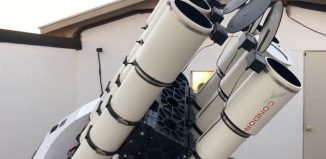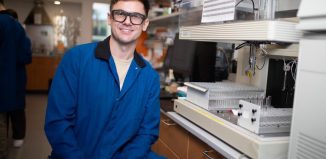BNL’s Peter Siddons: Making other’s research better
From fine tuning the synchrotron to authenticating a Rembrandt
In the late 1980s, just a few years after Peter Siddons started working at Brookhaven National Laboratory, a company called BASF ran ads with the line, “We don’t make a lot of the products you buy, we make the products you buy better.”
That idea is similar to the work Siddons does on BNL’s synchrotron: He doesn’t perform research, but he makes the research of other scientists better.
By being what he describes as a “gearhead,” Siddons, a native of Yorkshire, England, makes best use of the optics and the X-ray beams from the National Synchrotron Light Source to give scientists a fast, clear picture of small molecules and particles inside a wide range of objects.
When polymers melt, they go through a process called reptation, where they form long, linear entangled molecules (they look like a collection of snakes mixing together).
Andrei Fluerasu, a BNL scientist who has studied polymers, has worked with Siddons since he arrived three years ago and has been impressed with his colleague’s ability to fine-tune the detecting device.
He is “building a device that works exactly how it should,” Fluerasu said. “We can go 100 times faster and can detect things which move 100 times faster.”
Siddons has worked with scientists from all over the world, including Australian geologist Chris Ryan. The tandem first started collaborating a decade ago.
“We went through many generations of designs,” Ryan wrote in an email to the Times Beacon Record. Ryan praised Siddons, suggesting he had a “vision of new generations of detector technologies.”
Ryan said the enhanced detecting abilities have had applications in everything ranging from optimizing the availability of iron in rice, barley and wheat, to the study of organisms used as models for neurodegenerative diseases, to art.
Indeed, Siddons made headlines recently when he became involved in a debate over the effort to authenticate a painting called “Old Man with a Beard” that some art historians believed Rembrandt had created.
When he received the painting, it “took a while to figure out how to hold it without damaging it,” Siddons laughed. Once he worked out the logistics, Siddons used X-ray fluorescence on it to look deep inside the layers of the painting.
Using a detector called Maia, Siddons imaged the painting in eight hours. Using other technology, that analysis would have taken 30 days, Siddons said.
The approach showed there was a 400-year old image beneath the painting, likely of a younger self-portrait of Rembrandt. But that wasn’t where the effort ended. There was a third image hidden beneath the painting, of a person wearing a turban with a feather. There were enough similarities between these images and others done by the master painter to confirm that the “Old Man with a Beard” was an authentic Rembrandt.
“It was great fun,” concluded Siddons, who said he spent several evenings putting the data together.
One of his colleagues, noticing the similarity between the subject of the painting and Siddons, photoshopped the BNL scientist into a copy of the painting.
“It’s pretty convincing,” admitted Siddons, “except for the spectacles.”
While Siddons can appreciate a Rembrandt — and his role in authenticating one — the “gearhead” spends much more of his time in another cultural area, playing Renaissance music in a lecture room at BNL with his musically-inclined colleagues once a week on the guitar, recorder or other instruments.
Siddons lives in Cutchogue with his wife Elizabeth, who works across the street from his lab at the Physical Review. While they carpool to work, they rarely have lunch because she reserves that time for bridge.
They have three children: Giles, a vegan chef in Boston; Rebecca, a teacher in Providence, R.I. and Louise, an art professor at Oklahoma State University. Louise was the one who brought her father into the Rembrandt debate.
Siddons has a need to understand the benefits and limitations of technology, even outside the high-tech synchrotron where he works.
“I can’t use any instrument I haven’t taken to pieces,” he confesses. “It’s pathological. I used to do my own car maintenance. When I turn something on, I want to know where the warts are and what can go wrong.”






